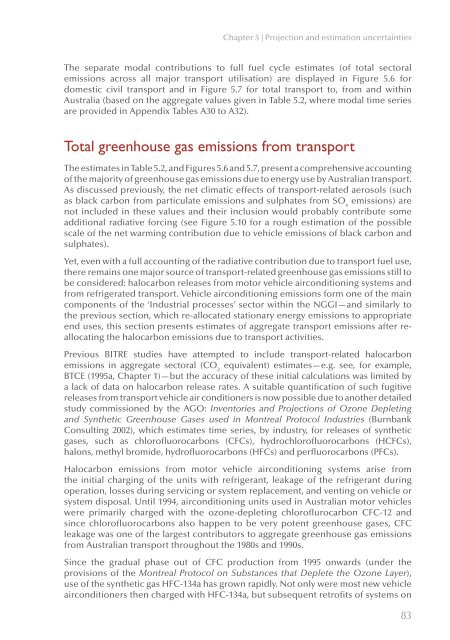PDF: 9795 KB - Bureau of Infrastructure, Transport and Regional ...
PDF: 9795 KB - Bureau of Infrastructure, Transport and Regional ...
PDF: 9795 KB - Bureau of Infrastructure, Transport and Regional ...
Create successful ePaper yourself
Turn your PDF publications into a flip-book with our unique Google optimized e-Paper software.
Chapter 5 | Projection <strong>and</strong> estimation uncertainties<br />
The separate modal contributions to full fuel cycle estimates (<strong>of</strong> total sectoral<br />
emissions across all major transport utilisation) are displayed in Figure 5.6 for<br />
domestic civil transport <strong>and</strong> in Figure 5.7 for total transport to, from <strong>and</strong> within<br />
Australia (based on the aggregate values given in Table 5.2, where modal time series<br />
are provided in Appendix Tables A30 to A32).<br />
Total greenhouse gas emissions from transport<br />
The estimates in Table 5.2, <strong>and</strong> Figures 5.6 <strong>and</strong> 5.7, present a comprehensive accounting<br />
<strong>of</strong> the majority <strong>of</strong> greenhouse gas emissions due to energy use by Australian transport.<br />
As discussed previously, the net climatic effects <strong>of</strong> transport-related aerosols (such<br />
as black carbon from particulate emissions <strong>and</strong> sulphates from SO x<br />
emissions) are<br />
not included in these values <strong>and</strong> their inclusion would probably contribute some<br />
additional radiative forcing (see Figure 5.10 for a rough estimation <strong>of</strong> the possible<br />
scale <strong>of</strong> the net warming contribution due to vehicle emissions <strong>of</strong> black carbon <strong>and</strong><br />
sulphates).<br />
Yet, even with a full accounting <strong>of</strong> the radiative contribution due to transport fuel use,<br />
there remains one major source <strong>of</strong> transport-related greenhouse gas emissions still to<br />
be considered: halocarbon releases from motor vehicle airconditioning systems <strong>and</strong><br />
from refrigerated transport. Vehicle airconditioning emissions form one <strong>of</strong> the main<br />
components <strong>of</strong> the ‘Industrial processes’ sector within the NGGI—<strong>and</strong> similarly to<br />
the previous section, which re-allocated stationary energy emissions to appropriate<br />
end uses, this section presents estimates <strong>of</strong> aggregate transport emissions after reallocating<br />
the halocarbon emissions due to transport activities.<br />
Previous BITRE studies have attempted to include transport-related halocarbon<br />
emissions in aggregate sectoral (CO 2<br />
equivalent) estimates—e.g. see, for example,<br />
BTCE (1995a, Chapter 1)—but the accuracy <strong>of</strong> these initial calculations was limited by<br />
a lack <strong>of</strong> data on halocarbon release rates. A suitable quantification <strong>of</strong> such fugitive<br />
releases from transport vehicle air conditioners is now possible due to another detailed<br />
study commissioned by the AGO: Inventories <strong>and</strong> Projections <strong>of</strong> Ozone Depleting<br />
<strong>and</strong> Synthetic Greenhouse Gases used in Montreal Protocol Industries (Burnbank<br />
Consulting 2002), which estimates time series, by industry, for releases <strong>of</strong> synthetic<br />
gases, such as chlor<strong>of</strong>luorocarbons (CFCs), hydrochlor<strong>of</strong>luorocarbons (HCFCs),<br />
halons, methyl bromide, hydr<strong>of</strong>luorocarbons (HFCs) <strong>and</strong> perfluorocarbons (PFCs).<br />
Halocarbon emissions from motor vehicle airconditioning systems arise from<br />
the initial charging <strong>of</strong> the units with refrigerant, leakage <strong>of</strong> the refrigerant during<br />
operation, losses during servicing or system replacement, <strong>and</strong> venting on vehicle or<br />
system disposal. Until 1994, airconditioning units used in Australian motor vehicles<br />
were primarily charged with the ozone-depleting chlor<strong>of</strong>lurocarbon CFC-12 <strong>and</strong><br />
since chlor<strong>of</strong>luorocarbons also happen to be very potent greenhouse gases, CFC<br />
leakage was one <strong>of</strong> the largest contributors to aggregate greenhouse gas emissions<br />
from Australian transport throughout the 1980s <strong>and</strong> 1990s.<br />
Since the gradual phase out <strong>of</strong> CFC production from 1995 onwards (under the<br />
provisions <strong>of</strong> the Montreal Protocol on Substances that Deplete the Ozone Layer),<br />
use <strong>of</strong> the synthetic gas HFC-134a has grown rapidly. Not only were most new vehicle<br />
airconditioners then charged with HFC-134a, but subsequent retr<strong>of</strong>its <strong>of</strong> systems on<br />
83

















